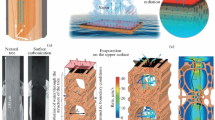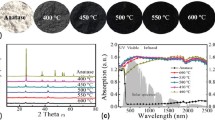Abstract
In the present paper, the performance of the graphene oxide in the solar steam generation has experimentally been examined. For this purpose, a setup was built for measuring the evaporation rate, which consists of a solar simulator with a xenon lamp as a radiation source, a pyranometer for light intensity measuring, and a sensory system for measuring the temperature and the mass. Then, the nanofluid with three nanoparticle mass concentrations of 0.001, 0.002, and 0.004% was prepared and exposed to the light intensity of 3.5 Suns (3.5 kW m−2). Finally, the effects of the light intensity variations on the solar steam generation were studied at the steady and transition conditions. The results showed that the examined carbon nanostructure is efficiently capable of direct solar energy harvesting, such that a maximum total efficiency of 78.9% at 3.5 Suns can be obtained, while the corresponding value for the case of pure water is about 54%. Furthermore, it was found that increasing the light intensity from 1.5 to 3.5 Suns enhances the evaporation flux rate, yet, reduces the evaporation efficiency.












Similar content being viewed by others
Abbreviations
- A :
-
Surface area (m2)
- Abs:
-
Light absorption (a.u.)
- C p :
-
Specific heat capacity (kJ kg−1 K−1)
- h fg :
-
Enthalpy of phase change (kJ kg−1)
- I :
-
Light intensity (kW m−2)
- M :
-
The initial mass of working fluid (g)
- \(\dot{m}\) :
-
Water evaporation flux rate (kg m−2 h−1)
- T :
-
Temperature (°C)
- t :
-
Time (s)
- \(\eta\) :
-
Efficiency (%)
- w :
-
Nanoparticle mass fraction (%)
- amb:
-
Ambient
References
Ghafurian MM, Niazmand H. New approach for estimating the cooling capacity of the absorption and compression chillers in a trigeneration system. Int J Refrig. 2018;86:89–106.
Chang C, Yang C, Liu Y, Tao P, Song C, Shang W, Wu J, Deng T. Efficient solar-thermal energy harvest driven by interfacial plasmonic heating-assisted evaporation. ACS Appl Mater Interface. 2016;8:23412–8.
Mahian O, Kianifar A, Zeinali Heris A, Wen D, Sahine AZ, Wongwises S. Nanofluids effects on the evaporation rate in a solar still equipped with a heat exchanger. Nano Energy. 2017;36:134–55.
Hjerrild NE, Taylor RA. Boosting solar energy conversion with nanofluids. Phys Today. 2017;70(12):40–5.
Neumann O, Urban AS, Day J, Lal S, Nordlander P, Halas NJ. Solar vapor generation enabled by nanoparticles. ACS Nano. 2013;7:42–9.
Neumann O, Feronti C, Neumann AD, Dong A, Schell K, Lu B, et al. Compact solar autoclave based on steam generation using broadband light-harvesting nanoparticles. Proc Natl Acad Sci. 2013;110:11677–81.
Ni G, Miljkovic N, Ghasemi H, Huang X, Boriskina SV, Lin C-T, et al. Volumetric solar heating of nanofluids for direct vapor generation. Nano Energy. 2015;17:290–301.
Li H, He Y, Liu Z, Huang Y, Jiang B. Synchronous steam generation and heat collection in a broadband Ag@TiO2 core–shell nanoparticle-based receiver. Appl Therm Eng. 2017;121:617–27.
Jin H, Lin G, Bai L, Zeiny A, Wen D. Steam generation in a nanoparticle-based solar receiver. Nano Energy. 2016;28:397–406.
Wang X, He Y, Cheng G, Shi L, Liu X, Zhu J. Direct vapor generation through localized solar heating via carbon nanotube nanofluid. Energy Convers Manag. 2016;130:176–83.
Amjad M, Raza Gh, Xin Y, Pervaiz Sh, Xu Ji DuX, Wen D. Volumetric solar heating and steam generation via gold nanofluids. Appl Energy. 2017;206:393–400.
Fu Y, Mei T, Wang G, Guo A, Dai G, Wang Sh, Wang J, Li J, Wang X. Investigation on enhancing effects of Au nanoparticles on solar steam generation in graphene oxide nanofluids. Appl Therm Eng. 2017;114:961–8.
Wang X, He Y, Liu X, Shi L, Zhu J. Investigation of photothermal heating enabled by plasmonic nanofluids for direct solar steam generation. Sol Energy. 2017;157:35–46.
Shi L, He Y, Huang Y, Jiang B. Recyclable Fe3O4@CNT nanoparticles for high-efficiency solar vapor generation. Energy Convers Manag. 2017;149:401–8.
Wang J, Li Y, Deng L, Wei N, Weng Y, Dong S, Qi D, Qiu J, Chen X, Wu T. High-performance photo thermal conversion of narrow-bandgap Ti2O3 nanoparticles. Adv Mater. 2017;29:1603730.
Liu X, Wang X, Huang J, Cheng G, He Y. Volumetric solar steam generation enhanced by reduced graphene oxide nanofluid. Appl Energy. 2018;220:302–12.
Wang X, He Y, Liu X, Zhu J. Enhanced direct steam generation via a bio-inspired solar heating, method using carbon nanotube films. Powder Technol. 2017;321:276–85.
Ghadimi A, Saidur R, Metselaar HSC. A review of nanofluid stability properties and characterization in stationary conditions. Int J Heat Mass Transf. 2011;54:4051–68.
Ahmed Sharafeldina M, Gróf G, Mahian O. Experimental study on the performance of a flat-plate collector using WO3/water nanofluids. Energy. 2017;141:2436–44.
Ghafurian MM, Niazmand H, Ebrahimnia bejestan E. Performance evaluation of multi-wall carbon nanotube in solar fresh water production. Articles in Press, Amirkabir Journal of Mechanical Engineering, Accepted Manuscript, Available Online from 12 May 2018.
Zielinski MS, Choi JW, La Grange T, Modestino M, Hashemi SM, Pu Y, Birkhold S, Hubbell JA, Psaltis D. Hollow mesoporous plasmonic nanoshells for enhanced solar vapor generation. Nano Lett. 2016;13:2159–67.
Swinehar DF. The Beer–Lambert law. J Chem Educ. 1962;39:333.
Wang X, He Y, Liu X, Cheng G, Zhu J. Solar steam generation through bio-inspired interface heating of broadband-absorbing plasmonic membranes. Appl Energy. 2017;195:414–25.
Ghasemi H, Ni G, Marconnet AM, Loomis J, Yerci S, Miljkovic N, et al. Solar steam generation by heat localization. Nat Commun. 2014;5:4449.
Author information
Authors and Affiliations
Corresponding author
Rights and permissions
About this article
Cite this article
Ghafurian, M.M., Niazmand, H., Ebrahimnia-Bajestan, E. et al. Localized solar heating via graphene oxide nanofluid for direct steam generation. J Therm Anal Calorim 135, 1443–1449 (2019). https://doi.org/10.1007/s10973-018-7496-0
Received:
Accepted:
Published:
Issue Date:
DOI: https://doi.org/10.1007/s10973-018-7496-0




